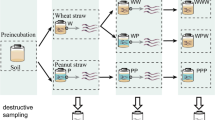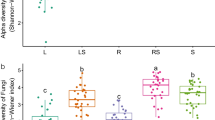Abstract
The community of culturable cellulolytic bacteria was analyzed in two long-term experimental field sites on Albic Luvisol (silty sand) and Haplic Phaeozem (loam), with and without farmyard manure treatment. Against the backdrop of significant differences in soil properties, the bacterial community structure differed clearly between sites and was affected by manure application as analyzed by T-RFLP of 16S rDNA. The population densities of cellulolytic bacteria were significantly increased by manure application in Phaeozem. Cellulose decomposing potentials of 537 isolates were tested on soluble, colloidal, and crystalline cellulose. The results showed some evidence of a greater proportion of isolates with high decomposition activity in Luvisol, but no impact from manure application could be observed in both soils. Restriction analysis and sequencing of 16S rDNA of isolates revealed a rather simple community composition that was dominated by Streptomyces (67%). The composition of the RFLP groups was affected by manure application, which was most evident in Luvisol, whereas an effect of the soil type could not be found. Although abundant RFLP groups were assigned to phylogenetically different bacterial classes (Actinobacteria, Betaproteobacteria, and Gammaproteobacteria), cellulolytic activity could not consistently be differentiated. All in all, cellulolytic capabilities of the isolates were highly variable and did not map to phylogenetic affiliation.





Similar content being viewed by others
References
Akasaka H, Izawa T, Ueki K, Ueki A (2003) Phylogeny of numerically abundant culturable anaerobic bacteria associated with degradation of rice plant residue in Japanese paddy field soil. FEMS Microbiol Ecol 43:149–161
Berg B, Laskowski R (2006) Litter decomposition: a guide to carbon and nutrient turnover. Adv Ecol Res Vol. 38. Elsevier, Amsterdam
Bergquist PL, Gibbs MD, Morris DD, Te’o VS, Saul DJ, Moran HW (1999) Molecular diversity of thermophilic cellulolytic and hemicellulolytic bacteria. FEMS Microbiol Ecol 28:99–110
Blackwood CB, Marsh T, Kim SH, Paul EA (2003) Terminal restriction fragment length polymorphism data analysis for quantitative comparison of microbial communities. Appl Environ Microbiol 69:926–932
Chun J, Goodfellow M (1995) A phylogenetic analysis of the genus Nocardia with 16S rRNA gene sequences. Int J Syst Bacteriol 45:240–245
Crawford DL (1998) Biodegradation of agricultural and urban wastes. In: Goodfellow M, Williams ST, Mordarski M (eds) Actinomycetes in biotechnology. Academic, London, pp 433–439
Dilly O, Bartsch S, Rosenbrock P, Buscot F, Munch JC (2001) Shifts in physiological capabilities of the microbiota during the decomposition of leaf litter in a black alder (Alnus glutinosa (Gaertn.) L.) forest. Soil Biol Biochem 33:921–930
DIN-ISO 13536 (1997) Bestimmung der potentiellen Kationenaustauschkapazität und Basensättigung. Beuth, Berlin Wien Zürich
Dunbar J, Ticknor LO, Kuske CR (2001) Phylogenetic specificity and reproducibility and new method for analysis of terminal restriction fragment profiles of 16S rRNA genes from bacterial communities. Appl Environ Microbiol 67:190–197
Dunger W, Fiedler HJ (1997) Methoden der Bodenbiologie. Gustav Fischer Verlag Jena, Stuttgart, Lübeck, Ulm
Ellmer F, Köhn W (2004) Versuchsführer 2004. Institut für Pflanzenbauwissenschaften, Landwirtschaftlich-Gärtnerische Fakultät, Humboldt-Universität zu Berlin
Eriksson KEL, Blanchette RA, Ander P (1990) Microbial and enzymatic degradation of wood and wood components, Ch. 2.6. Cellulose degradation by bacteria, Springer Series in Wood Science (Timell TE, ed.). Springer, Berlin
Esham EC, Ye W, Morgan MA (2000) Identification and characterization of humic substances-degrading bacterial isolates from an estuarine environment. FEMS Microbiol Ecol 34:103–111
Felsenstein J (1993) PHYLIP (Phylogeny Inference Package) version 3.6a2. Distributed by the author. Department of Genetics, University of Washington, Seattle
Garbeva P, van Veen JA, van Elsas JD (2004) Microbial diversity in soil: selection of microbial populations by plant and soil type and implications for disease suppressiveness. Annu Rev Phytopathol 42:243–270
Gilkes NR, Henrissat B, Kilburn DG, Miller RC Jr, Warren RAJ (1991) Domains in microbial β-1,4-glycanases: sequence conservation, function, and enzyme families. Microbiol Rev 55:303–315
Girvan MS, Bullimore J, Pretty JN, Osborn AM, Ball AS (2003) Soil type is the primary determinant of the composition of the total and active bacterial communities in arable soils. Appl Environ Microbiol 69:1800–1809
Halliwell G (1965) Hydrolysis of fibrous cotton and reprecipitated cellulose by cellulolytic enzymes from soil micro-organisms. Biochem J 96:270–281
Hartmann M, Fliessbach A, Oberholzer HR, Widmer F (2006) Ranking the magnitude of crop and farming systems on soil microbial biomass and genetic structure of bacterial communities. FEMS Microbiol Ecol 57:378–388
Hendricks CW, Doyle JD, Hugley B (1995) A new solid medium for enumerating cellulose-utilizing bacteria in soil. Appl Environ Microbiol 61:2016–2019
Hiroki M (1993) Effect of arsenic pollution on soil microbial population. Soil Sci Plant Nutr 2:227–235
Hiroki M, Watanabe MM (1996) Microbial community and rate of cellulose decomposition in peat soils in a mire. Soil Sci Plant Nutr 42:893–903
Körschens M, Pfefferkorn A (1998) Der Statische Düngungsversuch und andere Feldversuche. UFZ-Umweltforschungszentrum Leipzig-Halle GmbH
Larue R, Yu ZT, Parisi VA, Egan AR, Morrison M (2005) Novel microbial diversity adherent to plant biomass in the herbivore gastrointestinal tract, as revealed by ribosomal intergenic spacer analysis and rrs gene sequencing. Environ Microbiol 7:530–543
Lednicka D, Mergaert J, Cnockaert MC, Swings J (2000) Isolation and identification of cellulolytic bacteria involved in the degradation of natural cellulosic fibres. Syst Appl Microbiol 23:292–299
Lynd LR, Weimer PJ, van Zyl WH, Pretorius IS (2002) Microbial cellulose utilization: fundamentals and biotechnology. Microbiol Mol Biol Rev 66:506–577
Marschner P, Kandeler E, Marschner B (2003) Structure and function of the soil microbial community in a long-term fertilizer experiment. Soil Biol Biochem 35:453–461
Meiwes KJ, König N, Khanna PK, Prenzel J, Ulrich B (1984) Chemische Untersuchungsverfahren für Mineralboden, Auflagehumus und Wurzeln zur Charakterisierung und Bewertung der Versauerung in Waldböden, Berichte des Forschungszentrums Waldökosysteme, Vol. 7, Universität Göttingen
Meyers PR, Bourn WR, Steyn LM, van Helden PD, Beyers AD, Brown GD (1998) Novel method for rapid measurement of growth of Mycobacteria in detergent-free media. J Clin Microbiol 36:2752–2754
Munzel U, Hothorn LA (2001) A unified approach to simultaneous rank test procedures in the unbalanced one-way layout. Biomet J 43:553–569
O’Donnell AG, Seasman M, Macrae A, Waite I, Davies JT (2001) Plants and fertilisers as drivers of change in microbial community structure and function in soils. Plant Soil 232:135–145
Pourcher AM, Sutra L, Hébé I, Moguedet G, Bollet C, Simoneau P, Gardan L (2001) Enumeration and characterization of cellulolytic bacteria from refuse of a landfill. FEMS Microbiol Ecol 34:229–241
Rabinovich ML, Melnik MS, Bolobova AV (2002) Microbial cellulases. Appl Biochem Microbiol 38:305–321
Rogers JA, Hsu JC (2001) Multiple comparisons of biodiversity. Biomet J 43:617–625
Ruijssenaars HJ, Hartmans S (2001) Plate screening methods for the detection of polysaccharase-producing microorganisms. Appl Microbiol Biotechnol 55:143–149
Smalla K, Oros-Sichler M, Milling A, Heuer H, Baumgarte S, Becker R, Neuber G, Kropf S, Ulrich A, Tebbe CC (2007) Bacterial diversity of soils assessed by DGGE, T-RFLP and SSCP fingerprints of PCR-amplified 16S rRNA gene fragments: do the different methods provide similar results? J Microbiol Methods 69:470–479
Teather RM, Wood PJ (1982) Use of Congo red-polysaccharide interactions in enumeration and characterization of cellulolytic bacteria from bovine rumen. Appl Environ Microbiol 43:777–780
Thompson JD, Gibson TJ, Plewniak F, Jeanmougin F, Higgins DG (1997) The Clustal_X windows interface: flexible strategies for multiple sequence alignment aided by quality analysis tools. Nucleic Acids Res 25:4876–4882
Toyota K, Kuninaga S (2006) Comparison of soil microbial community between soils amended with or without farmyard manure. Appl Soil Ecol 33:39–48
Ulrich A, Becker R (2006) Soil parent material is a key determinant of the bacterial community structure in arable soils. FEMS Microbiol Ecol 56:430–443
Ulrich A, Wirth S (1999) Phylogenetic diversity and population densities of culturable cellulolytic soil bacteria across an agricultural encatchment. Microb Ecol 37:238–247
Wachinger G, Bronnenmeier K, Staudenberger WL, Schrempf H (1989) Identification of mycelium-associated cellulase from Streptomyces reticuli. Appl Environ Microbiol 55:2653–2657
Ward JH (1963) Hierarchical grouping to optimize an objective function. J Am Stat Ass 58:236
Weisburg WG, Barns SM, Pelletier DA, Lane DJ (1991) 16S ribosomal DNA amplification for phylogenetic study. J Bacteriol 173:697–703
Widmer F, Rasche F, Hartmann M, Fliessbach A (2006) Community structures and substrate utilization of bacteria in soils from organic and conventional farming systems of the DOK long-term field experiment. Appl Soil Ecol 33:294–307
Wirth S, Ulrich A (2002) Cellulose-degrading potentials and phylogenetic classification of carboxymethyl-cellulose decomposing bacteria isolated from soil. Syst Appl Microbiol 25:584–591
Wirth SJ, Wolf GA (1992) Micro-plate, colourimetric assay for endo-acting cellulase, xylanase, chitinase, 1,3-ß-glucanase and amylase extracted from forest soil horizons. Soil Biol Biochem 24:511–519
Wood TM, Garcia-Campayo V (1990) Enzymology of cellulose degradation. Biodegradation 1:147–161
Acknowledgments
We are grateful to Mrs. Sigune Weinert, Mrs. Martina Wiemer, and Mrs. Ilona Bartelt for their skillful technical assistance, and furthermore, to the ZALF Central Laboratory for the soil chemical analyses. We are grateful to Dr. W. Köhn (Berlin-Dahlem) and Dr. I. Merbach (Bad Lauchstädt) for providing site information and for their support. The project was funded by the German Science Foundation (DFG, UL 179/1).
Author information
Authors and Affiliations
Corresponding author
Rights and permissions
About this article
Cite this article
Ulrich, A., Klimke, G. & Wirth, S. Diversity and Activity of Cellulose-Decomposing Bacteria, Isolated from a Sandy and a Loamy Soil after Long-Term Manure Application. Microb Ecol 55, 512–522 (2008). https://doi.org/10.1007/s00248-007-9296-0
Received:
Revised:
Accepted:
Published:
Issue Date:
DOI: https://doi.org/10.1007/s00248-007-9296-0




